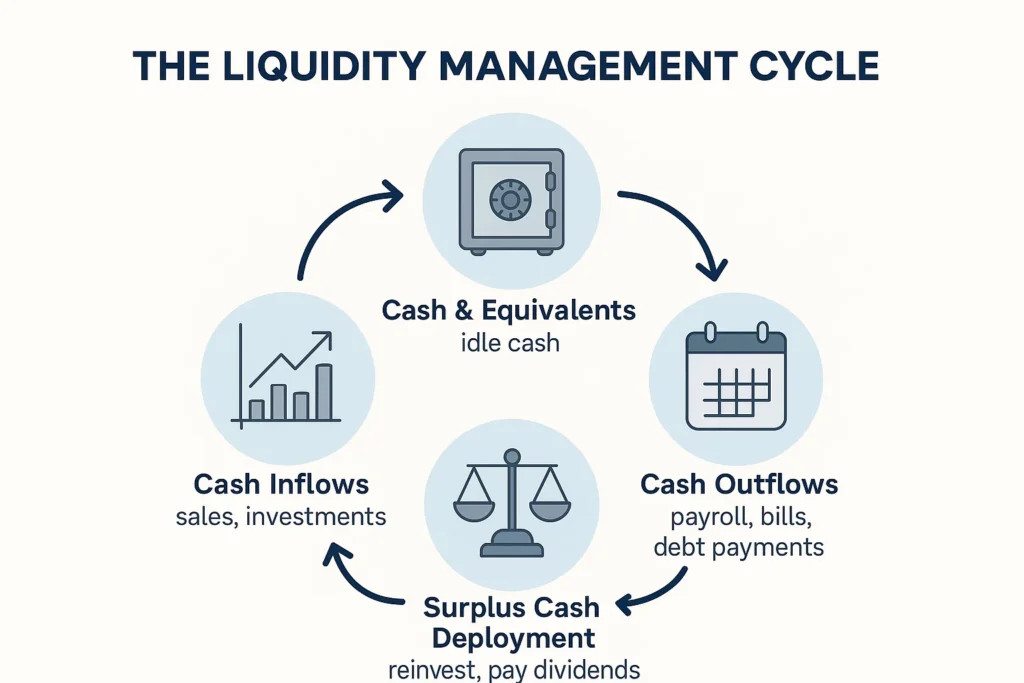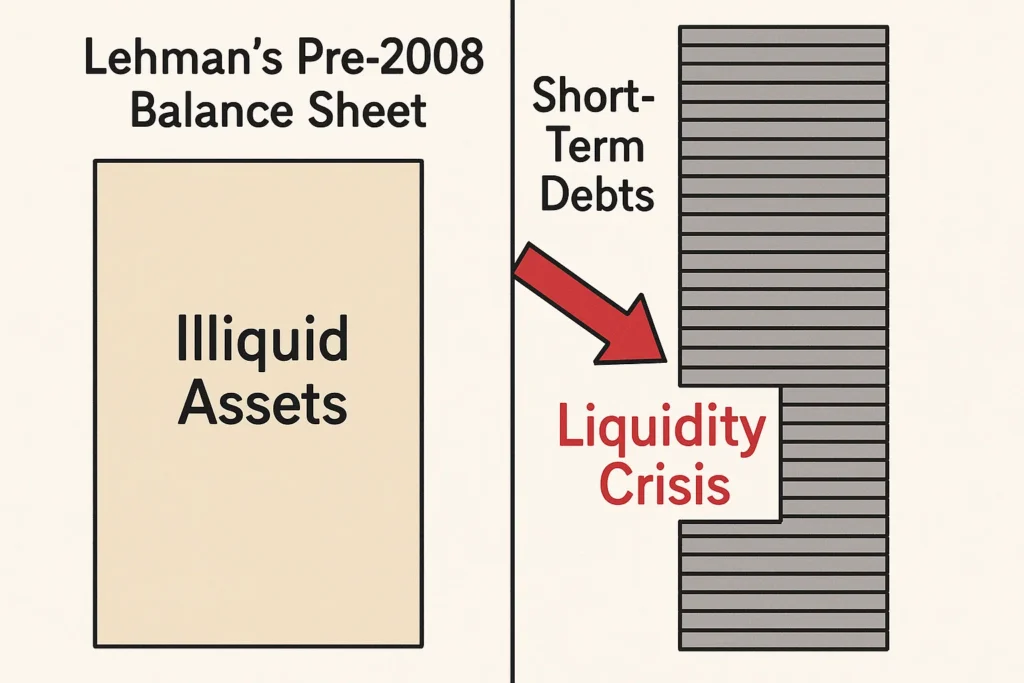
Liquidity Management What It Is and Why It's Crucial for Your Business
Liquidity management is the strategic process of ensuring a company or individual has immediate access to cash or assets that can be quickly converted to cash. It’s the lifeblood of any financial operation, determining the ability to meet short-term obligations and avoid a crisis. For businesses and investors in the US, UK, Canada, and Australia, mastering this is non-negotiable for survival and growth in volatile markets.
Summary Table
| Aspect | Detail |
|---|---|
| Definition | The process of managing cash flow and marketable assets to meet short-term financial obligations. |
| Also Known As | Cash Management, Treasury Management |
| Main Used In | Corporate Finance, Business Accounting, Personal Finance, Investment Portfolios |
| Key Takeaway | Poor liquidity management, not lack of profitability, is a primary cause of business failure. |
| Formula | Current Ratio = Current Assets / Current Liabilities (One of several) |
| Related Concepts |
What is Liquidity Management
At its core, liquidity management is about having the right amount of cash, in the right place, at the right time. Think of it like a ship navigating a narrow channel. If the water (cash) is too low, the ship runs aground (insolvency). If the water is too high, it represents an inefficient use of resources that could be deployed elsewhere (opportunity cost). It’s the daily discipline of ensuring there’s enough “water” to keep the ship afloat and moving forward, without flooding the deck.
Key Takeaways
The Core Concept Explained
Liquidity management measures an entity’s ability to cover its short-term debts (liabilities due within one year) without raising external capital or selling off long-term assets at a loss. A high degree of liquidity indicates a strong safety cushion, reducing financial risk. Conversely, low liquidity signals potential distress and an inability to seize new opportunities or weather downturns.

How to Measure Liquidity Management
While liquidity management itself is a process, its effectiveness is measured using specific financial ratios that analyze the balance sheet.
Key Liquidity Ratios
1. Current Ratio
- Formula: Current Ratio = Current Assets / Current Liabilities
- Interpretation: A ratio above 1.0 indicates more short-term assets than liabilities. A very high ratio may suggest inefficient use of assets.
2. Quick Ratio (Acid-Test)
- Formula: Quick Ratio = (Cash & Equivalents + Marketable Securities + Accounts Receivable) / Current Liabilities
- Interpretation: A more stringent measure that excludes inventory. A ratio of 1.0 or higher is generally considered good.
3. Cash Ratio
- Formula: Cash Ratio = (Cash & Equivalents + Marketable Securities) / Current Liabilities
- Interpretation: The most conservative ratio, showing the ability to pay off short-term debts immediately with cash on hand.
Example Calculation for a US-based Company:
Let’s analyze a hypothetical company, “TechNovate Inc.,” listed on the NASDAQ.
| Calculation | Formula | Result |
|---|---|---|
| Current Ratio | $1,500,000 / $1,000,000 | 1.5 |
| Quick Ratio | ($500,000 + $250,000 + $400,000) / $1,000,000 | 1.15 |
| Cash Ratio | ($500,000 + $250,000) / $1,000,000 | 0.75 |
Interpretation: TechNovate is in a solid liquidity position. Its Current and Quick Ratios are healthy, showing it can comfortably cover short-term debts. The Cash Ratio of 0.75 means it could cover 75% of its immediate liabilities with cash on hand, which is reasonable for a growing company.
Advanced Liquidity Management: The Cash Conversion Cycle (CCC)
While ratios are snapshots, the Cash Conversion Cycle (CCC) is a dynamic metric that measures how efficiently a company manages its working capital over time.
- Formula: CCC = Days Inventory Outstanding (DIO) + Days Sales Outstanding (DSO) – Days Payable Outstanding (DPO)
- What it Measures: The number of days it takes for a company to convert its investments in inventory and other resources into cash flows from sales.
- Interpretation: A shorter CCC is generally better. It means the company is quickly selling inventory, collecting cash from customers, and taking time to pay its suppliers. This frees up cash for other uses. Analyzing trends in a company’s CCC can reveal improving or deteriorating operational efficiency long before it shows up in earnings.
Why Liquidity Management Matters to Traders and Investors
- For Companies: It is the difference between solvency and bankruptcy. A profitable company can still fail if it can’t pay its suppliers or employees. It also provides the agility to capitalize on strategic opportunities like acquisitions or R&D investments.
- For Investors: Analyzing a company’s liquidity ratios is a fundamental step in due diligence. Strong liquidity suggests lower bankruptcy risk and a resilient business model, making it a safer investment. For investors in the UK’s FTSE or the US’s S&P 500, this is a key screening metric.
- For Traders: In the fast-moving crypto or forex markets, maintaining liquidity (available cash) in a trading account is critical. It allows traders to take advantage of new positions without being forced to sell other assets at a loss and helps them meet margin calls.
Liquidity Management for Cryptocurrency Investors and Traders
This is a modern, high-stakes application of the concept.
- The Challenge: Crypto markets can be highly volatile and illiquid, especially for smaller altcoins. A “liquid” position can become “illiquid” very quickly.
- Strategy 1: Stablecoin Allocation: Always maintain a portion of your portfolio in stablecoins (e.g., USDC, USDT). This is your “cash on the sidelines” to buy dips without selling other assets at a loss and to pay for trading fees.
- Strategy 2: Understand Exchange Depth: Before placing a large trade, check the order book depth. A thin order book means your large buy/sell order could significantly move the price (slippage), costing you money.
- Strategy 3: Beware of “Locked” Assets: Be cautious of staking or lending programs where your assets are locked up for a period. While they offer yield, they destroy your liquidity and ability to react to market moves.
How to Use Liquidity Management in Your Strategy
Use Case 1: For a Small Business Owner
- Action: Create a 13-week rolling cash flow forecast. Track every expected inflow (customer payments) and outflow (rent, payroll, supplier invoices).
- Benefit: This reveals future cash shortfalls weeks in advance, allowing you to arrange for a line of credit from your bank or delay non-essential expenditures.
Use Case 2: For a Stock Investor
- Action: Screen for companies with a Current Ratio between 1.5 and 3.0. This “sweet spot” indicates good liquidity without significant inefficiency.
- Benefit: It helps build a portfolio of financially stable companies that are less likely to cut dividends or issue dilutive shares during a recession.
Use Case 3: For a Portfolio Manager
- Action: Implement a “laddering” strategy for the portfolio’s cash and fixed-income portion, using highly liquid government bonds (like US Treasuries or UK Gilts) with staggered maturity dates.
- Benefit: This ensures a portion of the portfolio is consistently maturing, providing regular cash flow to reinvest or cover redemptions without selling assets in a down market.

Managing business cash flow effectively requires the right tools. Many modern accounting platforms automate this process.
- Risk Mitigation: Protects against insolvency and financial distress.
- Operational Stability: Ensures smooth day-to-day operations without funding hiccups.
- Strategic Advantage: Provides the “dry powder” needed to act on opportunities (e.g., buying a competitor’s assets cheaply during a downturn).
- Credibility: Improves creditworthiness with lenders and suppliers.
- Opportunity Cost: Holding too much cash or low-yield assets drags down overall returns (this is often called a “lazy balance sheet”).
- Inflation Risk: Idle cash loses purchasing power over time due to inflation.
- Ratio Blind Spots: Ratios are a snapshot in time and can be manipulated (e.g., window dressing before a reporting period). They don’t replace deep cash flow analysis.
Liquidity Management in the Real World: A Case Study
The Fall of Lehman Brothers (2008)
The collapse of Lehman Brothers is a catastrophic example of failed liquidity management. While the investment bank held vast assets, they were predominantly long-term, illiquid mortgage-backed securities. When the market for these assets froze, Lehman faced a massive wave of short-term obligations it could not meet. It couldn’t convert its assets to cash fast enough, leading to a liquidity crunch that resulted in the largest bankruptcy in US history. This underscores that the quality and convertibility of assets are just as important as their total value on paper.

Conclusion
Ultimately, understanding liquidity management provides a critical framework for ensuring financial resilience, whether you’re running a Fortune 500 company or managing a personal portfolio. While it offers the undeniable benefit of security and stability, as we’ve seen, an overly conservative approach carries the opportunity cost of lower returns. The key is to find an optimal balance tailored to your specific goals and risk tolerance. By incorporating liquidity analysis into your regular financial review, through cash flow forecasting and ratio monitoring, you can make more informed, strategic decisions that prioritize long-term solvency over short-term gambles.
Ready to put these concepts into action? The right tools are essential. We’ve meticulously reviewed and ranked the best online brokers for active traders and long-term investors to help you manage your portfolio’s liquidity effectively.
How Liquidity Management Relates to Other Concepts
A common point of confusion is the difference between Liquidity and Solvency.
| Feature | Liquidity | Solvency |
|---|---|---|
| What it measures | Short-term financial health | Long-term financial health |
| Time Horizon | < 12 months | > 12 months |
| Primary Focus | Ability to meet current obligations | Ability to cover all long-term debts |
| Key Ratios | Current Ratio, Quick Ratio | Debt-to-Equity, Interest Coverage Ratio |
A company can be illiquid but solvent (has long-term assets but no cash now), or liquid but insolvent (has cash but overwhelming long-term debt).
Related Terms
- Working Capital: The capital available for day-to-day operations, calculated as Current Assets – Current Liabilities. It’s the raw material of liquidity.
- Cash Flow Statement: The financial statement that provides a detailed record of the cash inflows and outflows over a period. It’s the report card for liquidity management.
- Capital Allocation: The broader strategy of how a company distributes its financial resources, which includes decisions on how much cash to hold.
- Market Liquidity: The degree to which an asset can be quickly bought or sold in the market without affecting its price. This is crucial for the “management” of a trading portfolio.






